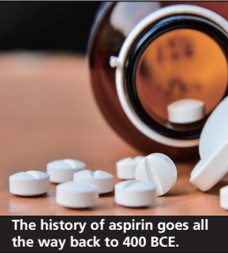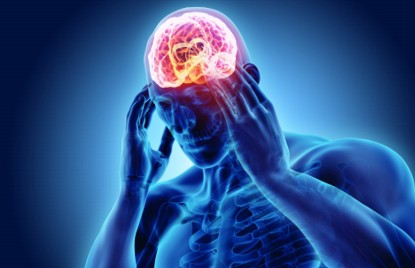
Think about the following questions.
1. How often do you get headaches?
2. When you get headaches, what do you do?
3. Is there anything you can do to avoid headaches?
VOCABULARY PREVIEW
Match each New Academic Word List(NAWL) word with the correct definition.
- tumor
- chemistry _____
- acid _____
- physiological _____
- productivity _____
- stimulus (pl. stimuli) _____
- a. something that causes a change or a reaction
- b. a mass of tissue in or on the body that is made of abnormal cells
- c. a chemical with a sour taste that forms a salt when mixed with a base
- d. the rate at which work is completed
- e. the structure and properties of a substance
- f. of or relating to how a living thing or its parts function
STUDYING HEADACHES

Headaches are a big problem. Each year, millions of people suffer from severe1 headaches that affect their enjoyment of life, not to mention their productivity at work. In fact, according to one estimate, headaches cost individuals and businesses more than $50 billion each year! This is one of the reasons research into headaches has become a worldwide effort.
Although he did not know much about how headaches work, Hippocrates2 was the first doctor to find a way to treat them. By 400 BCE, Hippocrates had discovered that the bark3 from willow trees4 was useful in treating pain. He made a white powder from the tree's bark and gave it to his patients.
Hippocrates did not know it, but he was actually prescribing a natural chemical in willow bark called salicin. When a person eats salicin, the chemical is changed inside his or her body into salicylic acid. It turns out that salicylic acid is good for stopping pain, including headache pain, but it is bad for a person's stomach. In the 1800s, a chemist in Germany slightly changed the acid's form to make it easier for people to take. This new form of the chemical was called acetylsalicylic acid, now commonly known as aspirin5. Aspirin was used throughout most of the 1900s to treat headaches, but doctors had little idea about what really caused headaches. When doctors can diagnose the cause of a disease, they can find better ways to treat it. Therefore, as medical technology developed, doctors began to use it to learn more about the human brain and about headaches.
Currently, doctors classify6 headaches into two general types: primary and secondary. A primary headache is a condition suffered as only the headache itself. On the other hand, a secondary headache is one caused by another physiological condition, such as an infection or a tumor.
For primary headaches, doctors have determined three possible causes. One kind of primary headache is caused by stress. Doctors usually call these tension7 headaches, and they are characteristically8 felt on both sides of the head as a dull, steady pain.
Another kind of primary headache is the migraine headache. Exactly what causes these headaches is not well understood, but many experts believe it could be abnormal brain activity causing changes in the brain's chemistry and blood flow. For many people, migraines are triggered9 by certain stimuli, such as poor sleep or particular foods or smells. A sufferer usually feels intense pain on one side of the head and becomes sensitive to light and noise. If the migraine is severe, the sufferer may vomit10 repeatedly.
The third kind of primary headache is known as the cluster headache. Cluster headaches typically occur around the same time each day for weeks or months at a time. The person suffering from this kind of headache usually feels pain on one side of her or his head, and the pain is centered around one of the eyes. Doctors do not know much at present about cluster headaches, but they seem to be more common among men and could be related to alcohol or other things that affect a person's blood flow.
Using computers and more advanced medical equipment, doctors continue to learn more about what happens in the brain before and during headaches. Especially in the case of migraines, some doctors believe they have found the part of the brain that sets off the reaction for severe attacks. With these insights into brain processes, doctors hope new ways will be discovered to stop headaches before they begin.
New Academic Word List
- severe 1 : adj. strong; very bad
- Hippocrates 2 : n. a Greek doctor who started the study of medicine
- bark 3 : n. the outer covering of a tree
- willow tree 4 : n. a tree with long, narrow leaves and strong, thin branches
- aspirin 5 : n. a medicine that reduces pain and fever
- classify 6 : v. to arrange into groups based on similarities
- tension 7 : n. stress
- characteristically 8 : adv. usually; typically
- trigger 9 : v. to cause to begin
- vomit 10 : v. to empty the contents of one's stomach through the mouth; to throw up
READING COMPREHENSION
A ‣ Mark each statement as true (T) or false (F) according to the reading.
- The first treatment for headaches was discovered over 2,000 years ago.
- True
- False
- Salicylic acid hurts people's stomachs.
- True
- False
- A primary headache may be caused by a tumor.
- True
- False
- Migraine sufferers have symptoms other than headache pain.
- True
- False
- Cluster headaches appear to be caused by stress.
- True
- False
B ‣ Choose the best answer according to the reading.
- What was the first treatment for headaches?
- a. Powder from the outer part of a tree
- b. Powder from tree roots
- c. Salicylic acid in liquid form
- d. Acetylsalicylic acid
- What is the main topic of paragraph 3?
- a. The origins of aspirin
- b. The definition of salicylic acid
- c. The process of making acetylsalicylic acid
- d. The effectiveness of aspirin for pain relief
- In paragraph 3, the word form means _____.
- a. size
- b. name
- c. structure
- d. category
- What is NOT a possible cause of a primary headache?
- a. a reduced flow of blood
- b. alcohol
- c. stress
- d. the flu
C ‣ Fill in the blanks with information from the reading.
- Most people know acetylsalicylic acid as _____.
- Certain _____ or _____, other stimuli, can trigger a migraine.
- _____ and _____ headaches usually involve pain on one side of the head.
SUMMARY
Fill in the blanks with the phrases in the box.
- different triggers
- lives and productivity
- another condition
- especially on migraines
- weeks or months
- from willow bark
|
Studying headaches is important because they affect people's 1 _____ worldwide. |
||
|
History
|
Types
|
Future
|
VOCABULARY PRACTICE
Fill in the blanks with the words in the box. Change the form if necessary.
- physiological
- tumor
- productivity
- stimulus
- chemistry
- acid
- Lemons and similar fruits contain citric _____, which gives them their sharp flavor.
- Scientist are studying the _____ of the ozone layer to help find solutions to global warming.
- It is not clear whether the patient's pain has a psychological or _____ cause.
- The bump on the dog's ear is a(n) _____, but luckily, it is not cancerous.
- You can train an animal to respond to a certain _____ , such as the sound of a bell.
- _____ in the office greatly increased when the use of social-media sites was banned.
SUPPLEMENTAL READING
Fighting Migraines

Aspirin works well for fighting minor headaches, but it might not be the best choice for dealing with migraines. Doctors have found that after a migraine sufferer is treated with aspirin, the person's next migraine attack may be even worse. Therefore, experts have been searching for other ways to treat these headaches.
For example, doctors have learned that certain cells in parts of the brain release proteins during a migraine attack. By using a drug that acts like the natural chemical serotonin in the brain, they can stop the cells from releasing those proteins. This has the effect of blocking the migraine.
But that is only one kind of medicine doctors have found useful in fighting migraines. It also turns out that certain anti-depressant drugs work well to relieve migraines. And surprisingly, some migraine sufferers claim Botox has proven helpful for them. (Botox is a chemical injected into the face for the purpose of reducing wrinkles.)
Not all migraine sufferers turn to medicine for help with their problem. Others use alternative remedies. Many people use yoga or meditation to relieve stress and reduce the number of migraines they suffer. And in some cases, people know that certain foods or fluorescent lights trigger their migraines. These people simply try to avoid the things that set off their migraine attacks.
Fill in the blanks with information from the reading.
- During a migraine attack, certain parts of the brain release _____.
- Anti-depressant drugs and Botox have been found to _____ migraines.
- Florescent lights and certain types of food can _____ migraines.

Leave a comment
Load more